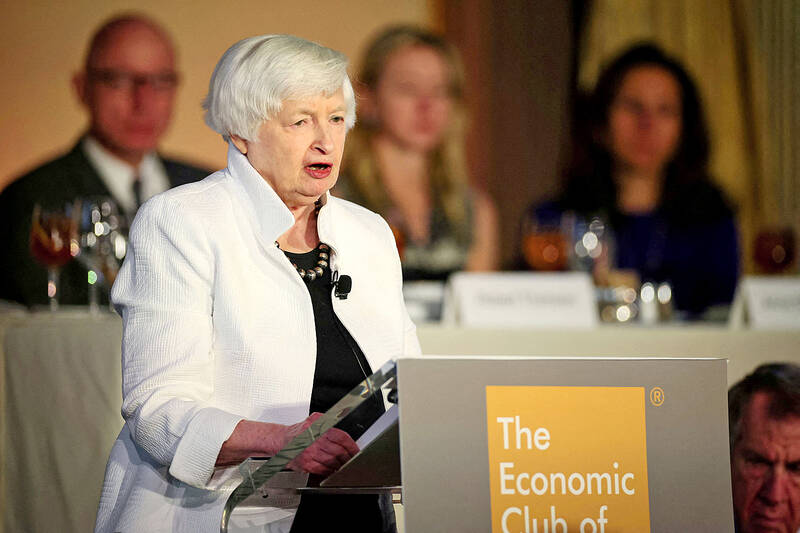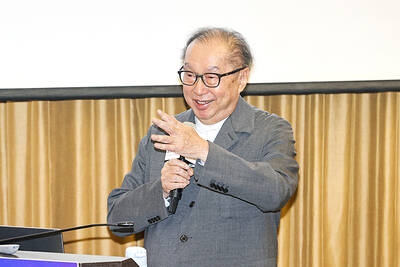The US Department of the Treasury on Thursday said no major trading partner appeared to have manipulated its currency last year, but it added Japan to a foreign exchange “monitoring list,” alongside China, Vietnam, Taiwan, Malaysia, Singapore and Germany, which were on the previous list.
The Treasury’s semi-annual currency report found that none of the countries examined met all three criteria triggering “enhanced analysis” of their foreign exchange practices during the four quarters through December last year.
Countries are automatically added to the list if they meet two of the three criteria: a trade surplus with the US of at least US$15 billion, a global account surplus above 3 percent of GDP and persistent one-way net foreign exchange purchases of at least 2 percent of GDP over 12 months.

Photo: Reuters
Japan, Taiwan, Vietnam and Germany all met the criteria for trade surpluses and an outsized current account surplus, the Treasury said.
Singapore met the criteria for engaging in persistent foreign exchange intervention and a material current account surplus; Malaysia only met the current account surplus criteria, but once on the list, it takes two currency report cycles to be dropped off.
China was kept on the monitoring list because of its large trade surplus with the US and because of a lack of transparency surrounding its foreign exchange policies.
“China’s failure to publish foreign exchange intervention and broader lack of transparency around key features of its exchange rate mechanism continues to make it an outlier among major economies and warrants Treasury’s close monitoring,” the Treasury said in the report.
The report also raises questions about China’s reporting of data on its current account balance, which showed its surplus fell to 1.4 percent of GDP last year from 2.5 percent in 2022.
The Treasury said China’s balance of payments data published by the State Administration of Foreign Exchange on the nation’s trade surplus appear to be at odds with China’s own customs data and that of other trading partners.
A US Treasury official said the department was trying to understand such “anomalies.”
The official said Japan’s recent foreign exchange interventions to prop up the yen were not a factor in deciding to add the country to the currency monitoring list.
The official cited Japan’s high trade surplus of US$62.4 billion with the US and its global current account surplus of 3.5 percent of GDP last year, up from 1.8 percent in 2022.
However, the Treasury report said that Japan had intervened in April and last year — outside the period covered by the report — for the first time since October 2022, buying yen and selling US dollars to boost the yen’s value.
The Treasury said Japan was transparent in its foreign exchange operations, but added: “Treasury’s expectation is that in large, freely traded exchange markets, intervention should be reserved only for very exceptional circumstances with appropriate prior consultations.”
Speaking to reporters on Thursday, Japan’s top currency diplomat, Vice Minister for International Affairs Masato Kanda, said he did not see a problem with Japan being included on the US currency monitoring list, adding that it was assessed according to mechanical criteria.
The report said most foreign exchange interventions last year focused on selling US dollars — actions that strengthen a currency’s value against the greenback.
The US dollar has strengthened over the past two years as the US Federal Reserve has raised interest rates sharply to cool inflation.
The greater concern in the Treasury report is on interventions to buy US dollars and thus weaken other currencies.

BYPASSING CHINA TARIFFS: In the first five months of this year, Foxconn sent US$4.4bn of iPhones to the US from India, compared with US$3.7bn in the whole of last year Nearly all the iPhones exported by Foxconn Technology Group (富士康科技集團) from India went to the US between March and last month, customs data showed, far above last year’s average of 50 percent and a clear sign of Apple Inc’s efforts to bypass high US tariffs imposed on China. The numbers, being reported by Reuters for the first time, show that Apple has realigned its India exports to almost exclusively serve the US market, when previously the devices were more widely distributed to nations including the Netherlands and the Czech Republic. During March to last month, Foxconn, known as Hon Hai Precision Industry

Taiwan Semiconductor Manufacturing Co (TSMC, 台積電) and the University of Tokyo (UTokyo) yesterday announced the launch of the TSMC-UTokyo Lab to promote advanced semiconductor research, education and talent development. The lab is TSMC’s first laboratory collaboration with a university outside Taiwan, the company said in a statement. The lab would leverage “the extensive knowledge, experience, and creativity” of both institutions, the company said. It is located in the Asano Section of UTokyo’s Hongo, Tokyo, campus and would be managed by UTokyo faculty, guided by directors from UTokyo and TSMC, the company said. TSMC began working with UTokyo in 2019, resulting in 21 research projects,

Ashton Hall’s morning routine involves dunking his head in iced Saratoga Spring Water. For the company that sells the bottled water — Hall’s brand of choice for drinking, brushing his teeth and submerging himself — that is fantastic news. “We’re so thankful to this incredible fitness influencer called Ashton Hall,” Saratoga owner Primo Brands Corp’s CEO Robbert Rietbroek said on an earnings call after Hall’s morning routine video went viral. “He really helped put our brand on the map.” Primo Brands, which was not affiliated with Hall when he made his video, is among the increasing number of companies benefiting from influencer

Quanta Computer Inc (廣達) chairman Barry Lam (林百里) yesterday expressed a downbeat view about the prospects of humanoid robots, given high manufacturing costs and a lack of target customers. Despite rising demand and high expectations for humanoid robots, high research-and-development costs and uncertain profitability remain major concerns, Lam told reporters following the company’s annual shareholders’ meeting in Taoyuan. “Since it seems a bit unworthy to use such high-cost robots to do household chores, I believe robots designed for specific purposes would be more valuable and present a better business opportunity,” Lam said Instead of investing in humanoid robots, Quanta has opted to invest